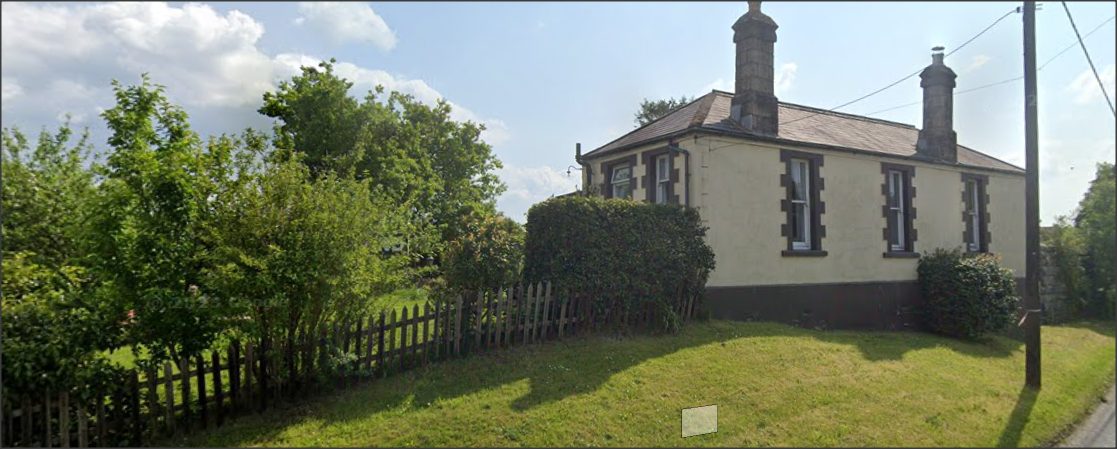About Dousland Station
Dousland Station was a picturesque stop on the Princetown Railway, situated at milepost 1¾ from Yelverton. The station was located on a curve, giving it a distinctive appearance. The platform on the down side of the station was constructed with stone infill, faced with brick, and topped with loose stone chippings. In later years, a timber extension was added at the western end of the platform, which was backed by a high granite wall. At the eastern end stood the signal box and station building.
The signal box, known as the “Dousland Barn Signal Box,” was small and almost toy-like in appearance. Its windows were often filled with geraniums, adding a touch of charm to its utilitarian design. Built from granite, the signal box was partially integrated into the boundary wall, with its height only 10 feet at platform level. The roof, a timber apex design, was covered with slates and finished with zinc sheeting at the ridges. Its eight timber-framed windows provided all-around visibility of the line.
The station building, like the signal box, was constructed of brick and rendered with cement. The road-facing side featured three windows, each surrounded by a decorative castellated design, and two limestone chimneys rose from the slate roof. On the platform side, the roof extended to form a small porch or canopy, providing shelter for passengers. Inside the building were the main office, ticket office, parcels office, waiting room, and a ladies’ toilet, with a separate gents’ toilet accessible from the platform.
To the east of the station stood the goods shed, a small and “toylike” structure, echoing the architectural style of the main building. It featured a goods platform that stretched the width of the building, with a ramp leading up to it. A small canopy protected the opening onto the platform, while a loading bay for road traffic was situated at the western end of the shed.
Beyond the goods shed was a coal store, a rather ramshackle structure built of corrugated iron supported by a wooden framework. The coal store opened onto a rough stone platform, which was used to serve the station’s coal requirements.
The station’s level crossing, located at the far eastern end, featured typical GWR-style wooden cross-frame gates, reinforced with steel stays. The crossing was operated remotely by the ground frame, housed in a brick and cement-rendered building with multi-paned windows. North of the gates stood the station master’s cottage, which still survives today as “Crossings Cottage,” though it has been extensively modernised and extended since its days as a railway residence.
In its prime, Dousland Station was an essential part of the Princetown line, serving both passengers and freight. The surrounding area, with its scenic views of Dartmoor and its proximity to Burrator Lake, made it a popular stop for hikers and nature enthusiasts. Today, although the station itself has long been out of service, the main building still stands as a reminder of the station’s role in the history of the Princetown Railway.
In Brief
Dousland railway station, originally established at Dousland Barn in 1883, was situated along the 10.5-mile-long single-track branch railway line in Devon, England, running from Yelverton to Princetown, with four intermediate stops, including three halts and a fully-fledged station at Dousland.
The station operated without a passing loop, serving as a block post that divided the line into two sections. It featured a goods yard, signal box, goods shed, and a level crossing equipped with gates. In 1915, the signal box near the level crossing was replaced by a new one located on the platform, which was subsequently renamed Dousland from Dousland Barn.
Today, much of the original track alignment serves as the pathway for the Dousland to Princetown Railway Track. The former Dousland station house still stands as a private residence, and remnants of the platform are still visible.

An intriguing proposal was reported in the Western Evening Herald in 1956 by Mr P. Morshead, with the support of Lydford Parish Council. The proposal involved purchasing the track, converting it to a narrow gauge, and utilizing three narrow gauge tank locomotives to operate trains between Yelverton and Dousland, with the aim of generating revenue to potentially reopen the remainder of the line.
Plymouth Live article here.
“DOUSLAND [Great Western Railway] opened 11 August 1883 (Tavistock 17th); closed 5 March 1956 (T 5th)” (source: here)
more follows

